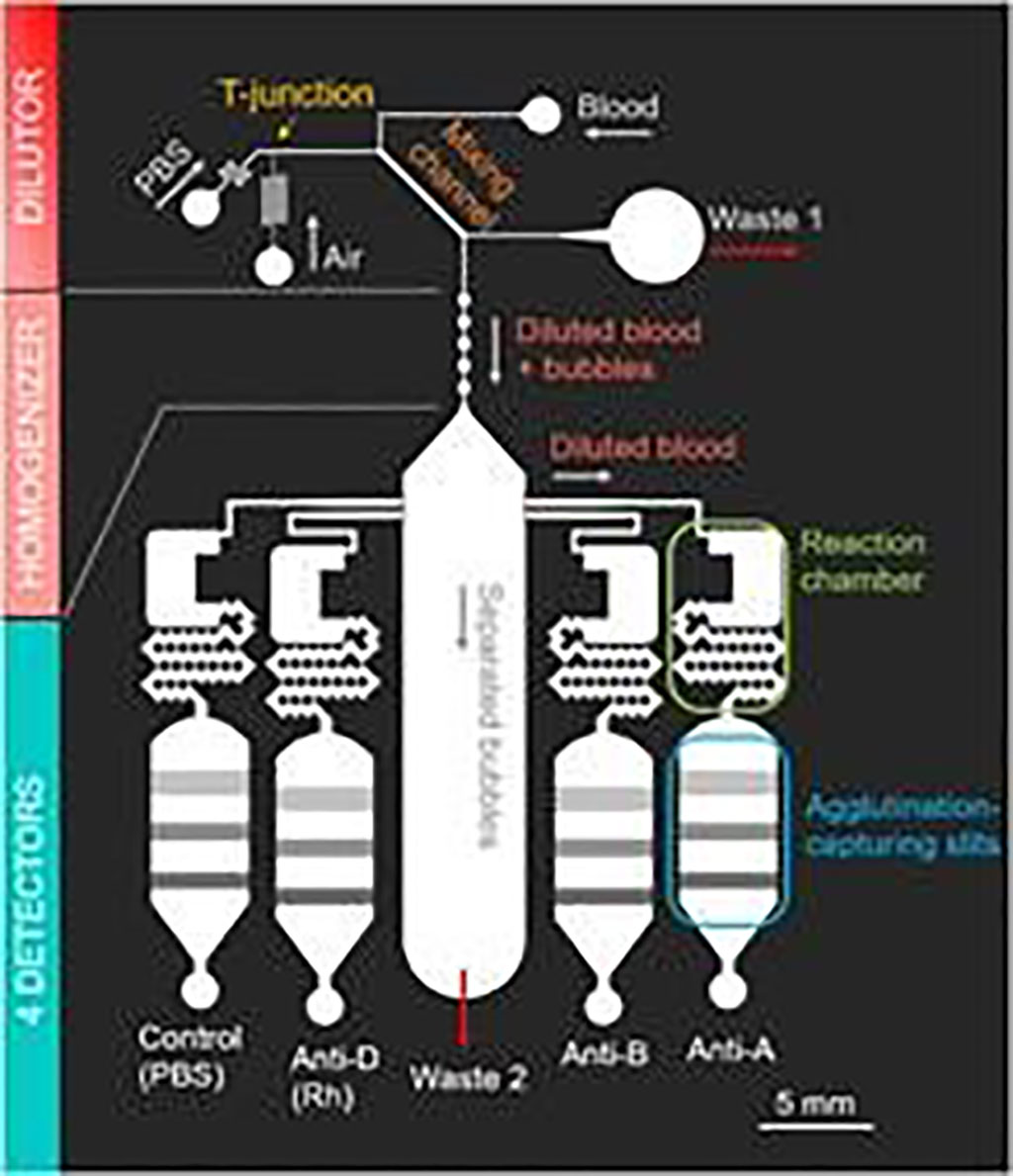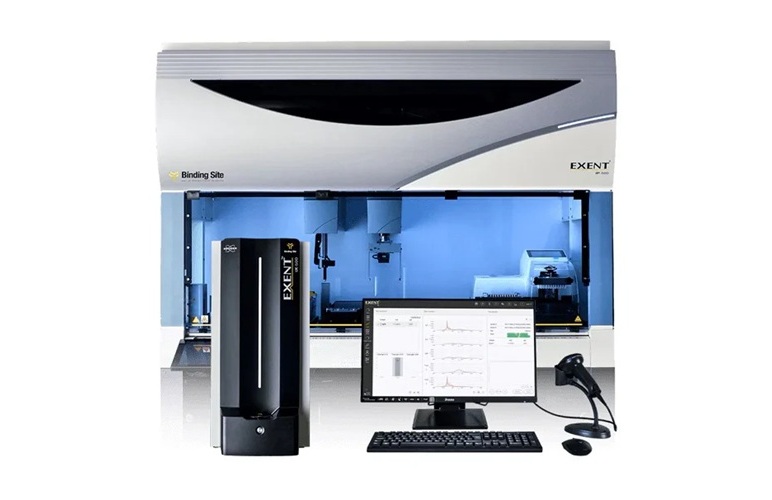Micro-Lab on a Chip Detects Blood Type Within Minutes
|
By LabMedica International staff writers Posted on 27 Jul 2020 |

Image: Schematic diagram of the fully-automatic blood-typing chip exploiting bubbles for quick dilution and detection (Photo courtesy of Tokyo University of Science).
Blood transfusion, if performed promptly, is a potentially life-saving intervention for someone losing a lot of blood. However, blood comes in several types, some of which are incompatible with others. Transfusing an incompatible blood type can severely harm a patient.
There are four major blood types, O, A, B, and AB. These types differ based on the presence or absence of structures called A antigens and B antigens on the surfaces of red blood cells. Blood can be further divided into positive and negative types based on the presence or absence of D antigens on red blood cells. Medical professionals usually tell a patient's blood type with tests involving antibodies against the A and B antigens.
Scientists at the Tokyo University of Science (Tokyo, Japan) developed a fully automated chip that can quickly and reliably determine a patient's blood type. The chip contains a micro-sized "laboratory" with various compartments through which the blood sample travels in sequence and is processed until results are obtained. To start the process, a user simply inserts a small amount of blood, presses a button, and waits for the result. Inside the chip, the blood is first diluted with a saline solution and air bubbles are introduced to promote mixing. The diluted blood is transported to a homogenizer where further mixing, driven by more intensely moving bubbles, yields a uniform solution.
Portions of the homogenized blood solution are introduced into four different detector chambers. Two chambers each contain reagents that can detect either A antigens or B antigens. A third chamber contains reagents that detect D antigens and a fourth chamber contains only saline solution, with no reagent, and serves as a negative control chamber in which the user should not observe any results. Antigen-antibody reaction will cause blood to agglutinate, and by looking at which chambers have hemagglutination, the user can tell the blood type and whether the blood is positive or negative. The team screened blood samples from 10 donors and obtained accurate results for all 10 samples. The time needed to determine a single sample's blood type was only five minutes.
Masahiro Motosuke, PhD, an associate professor and co-author of the study, said, “The advancement of simple and quick blood test chip technologies will lead to the simplification of medical care in emergency situations and will greatly reduce costs and the necessary labor on parts of medical staff.” The study was originally published online on April 14, 2020 in the journal Biomicrofluidics.
Related Links:
Tokyo University of Science
There are four major blood types, O, A, B, and AB. These types differ based on the presence or absence of structures called A antigens and B antigens on the surfaces of red blood cells. Blood can be further divided into positive and negative types based on the presence or absence of D antigens on red blood cells. Medical professionals usually tell a patient's blood type with tests involving antibodies against the A and B antigens.
Scientists at the Tokyo University of Science (Tokyo, Japan) developed a fully automated chip that can quickly and reliably determine a patient's blood type. The chip contains a micro-sized "laboratory" with various compartments through which the blood sample travels in sequence and is processed until results are obtained. To start the process, a user simply inserts a small amount of blood, presses a button, and waits for the result. Inside the chip, the blood is first diluted with a saline solution and air bubbles are introduced to promote mixing. The diluted blood is transported to a homogenizer where further mixing, driven by more intensely moving bubbles, yields a uniform solution.
Portions of the homogenized blood solution are introduced into four different detector chambers. Two chambers each contain reagents that can detect either A antigens or B antigens. A third chamber contains reagents that detect D antigens and a fourth chamber contains only saline solution, with no reagent, and serves as a negative control chamber in which the user should not observe any results. Antigen-antibody reaction will cause blood to agglutinate, and by looking at which chambers have hemagglutination, the user can tell the blood type and whether the blood is positive or negative. The team screened blood samples from 10 donors and obtained accurate results for all 10 samples. The time needed to determine a single sample's blood type was only five minutes.
Masahiro Motosuke, PhD, an associate professor and co-author of the study, said, “The advancement of simple and quick blood test chip technologies will lead to the simplification of medical care in emergency situations and will greatly reduce costs and the necessary labor on parts of medical staff.” The study was originally published online on April 14, 2020 in the journal Biomicrofluidics.
Related Links:
Tokyo University of Science
Latest Hematology News
- Platelet Activity Blood Test in Middle Age Could Identify Early Alzheimer’s Risk
- Microvesicles Measurement Could Detect Vascular Injury in Sickle Cell Disease Patients
- ADLM’s New Coagulation Testing Guidance to Improve Care for Patients on Blood Thinners
- Viscoelastic Testing Could Improve Treatment of Maternal Hemorrhage
- Pioneering Model Measures Radiation Exposure in Blood for Precise Cancer Treatments
- Platelets Could Improve Early and Minimally Invasive Detection of Cancer
- Portable and Disposable Device Obtains Platelet-Rich Plasma Without Complex Equipment
- Disposable Cartridge-Based Test Delivers Rapid and Accurate CBC Results
- First Point-of-Care Heparin Monitoring Test Provides Results in Under 15 Minutes

- New Scoring System Predicts Risk of Developing Cancer from Common Blood Disorder
- Non-Invasive Prenatal Test for Fetal RhD Status Demonstrates 100% Accuracy
- WBC Count Could Predict Severity of COVID-19 Symptoms
- New Platelet Counting Technology to Help Labs Prevent Diagnosis Errors
- Streamlined Approach to Testing for Heparin-Induced Thrombocytopenia Improves Diagnostic Accuracy
- POC Hemostasis System Could Help Prevent Maternal Deaths
- New Test Assesses Oxygen Delivering Ability of Red Blood Cells by Measuring Their Shape
Channels
Clinical Chemistry
view channel
Chemical Imaging Probe Could Track and Treat Prostate Cancer
Prostate cancer remains a leading cause of illness and death among men, with many patients eventually developing resistance to standard hormone-blocking therapies. These drugs often lose effectiveness... Read more
Mismatch Between Two Common Kidney Function Tests Indicates Serious Health Problems
Creatinine has long been the standard for measuring kidney filtration, while cystatin C — a protein produced by all human cells — has been recommended as a complementary marker because it is influenced... Read moreMolecular Diagnostics
view channel
Blood Test to Help Low-Risk Gastric Cancer Patients Avoid Unnecessary Surgery
Accurately identifying lymph node metastasis in early-stage gastric cancer remains a major clinical challenge. CT imaging often misses up to half of lymph node–positive cases, leading clinicians to recommend... Read more
First-Of-Its-Kind Automated System Speeds Myeloma Diagnosis
More than 176,000 people are diagnosed with multiple myeloma worldwide each year, yet the current diagnostic pathway can be slow and uncertain, often relying on a highly subjective interpretation of test results.... Read moreImmunology
view channel
Gene Signature Test Predicts Response to Key Breast Cancer Treatment
DK4/6 inhibitors paired with hormone therapy have become a cornerstone treatment for advanced HR+/HER2– breast cancer, slowing tumor growth by blocking key proteins that drive cell division.... Read more
Chip Captures Cancer Cells from Blood to Help Select Right Breast Cancer Treatment
Ductal carcinoma in situ (DCIS) accounts for about a quarter of all breast cancer cases and generally carries a good prognosis. This non-invasive form of the disease may or may not become life-threatening.... Read moreMicrobiology
view channel
Rapid Assay Identifies Bloodstream Infection Pathogens Directly from Patient Samples
Bloodstream infections in sepsis progress quickly and demand rapid, precise diagnosis. Current blood-culture methods often take one to five days to identify the pathogen, leaving clinicians to treat blindly... Read more
Blood-Based Molecular Signatures to Enable Rapid EPTB Diagnosis
Extrapulmonary tuberculosis (EPTB) remains difficult to diagnose and treat because it spreads beyond the lungs and lacks easily accessible biomarkers. Despite TB infecting 10 million people yearly, the... Read more
15-Minute Blood Test Diagnoses Life-Threatening Infections in Children
Distinguishing minor childhood illnesses from potentially life-threatening infections such as sepsis or meningitis remains a major challenge in emergency care. Traditional tests can take hours, leaving... Read more
High-Throughput Enteric Panels Detect Multiple GI Bacterial Infections from Single Stool Swab Sample
Gastrointestinal (GI) infections are among the most common causes of illness worldwide, leading to over 1.7 million deaths annually and placing a heavy burden on healthcare systems. Conventional diagnostic... Read morePathology
view channelAI Tool Outperforms Doctors in Spotting Blood Cell Abnormalities
Diagnosing blood disorders depends on recognizing subtle abnormalities in cell size, shape, and structure, yet this process is slow, subjective, and requires years of expert training. Even specialists... Read more
AI Tool Rapidly Analyzes Complex Cancer Images for Personalized Treatment
Complex digital biopsy images that typically take an expert pathologist up to 20 minutes to assess can now be analyzed in about one minute using a new artificial intelligence (AI) tool. The technology... Read moreTechnology
view channel
AI Saliva Sensor Enables Early Detection of Head and Neck Cancer
Early detection of head and neck cancer remains difficult because the disease produces few or no symptoms in its earliest stages, and lesions often lie deep within the head or neck, where biopsy or endoscopy... Read more
AI-Powered Biosensor Technology to Enable Breath Test for Lung Cancer Detection
Detecting lung cancer early remains one of the biggest challenges in oncology, largely because current tools are invasive, expensive, or unable to identify the disease in its earliest phases.... Read moreIndustry
view channel
Abbott Acquires Cancer-Screening Company Exact Sciences
Abbott (Abbott Park, IL, USA) has entered into a definitive agreement to acquire Exact Sciences (Madison, WI, USA), enabling it to enter and lead in fast-growing cancer diagnostics segments.... Read more























